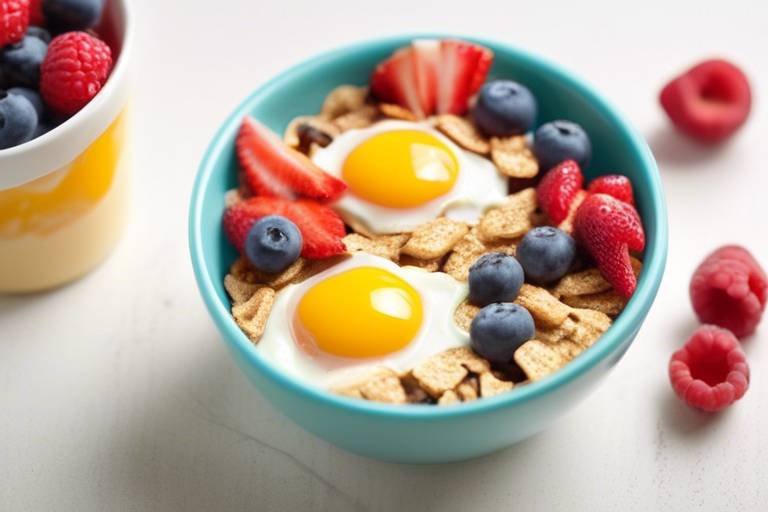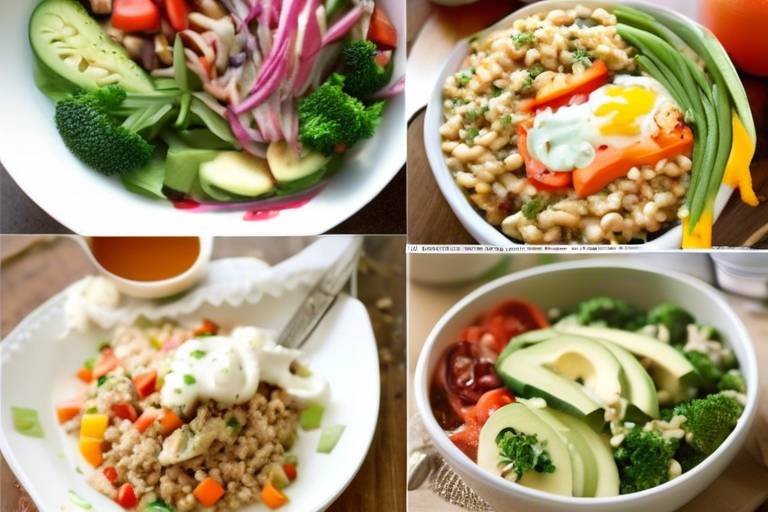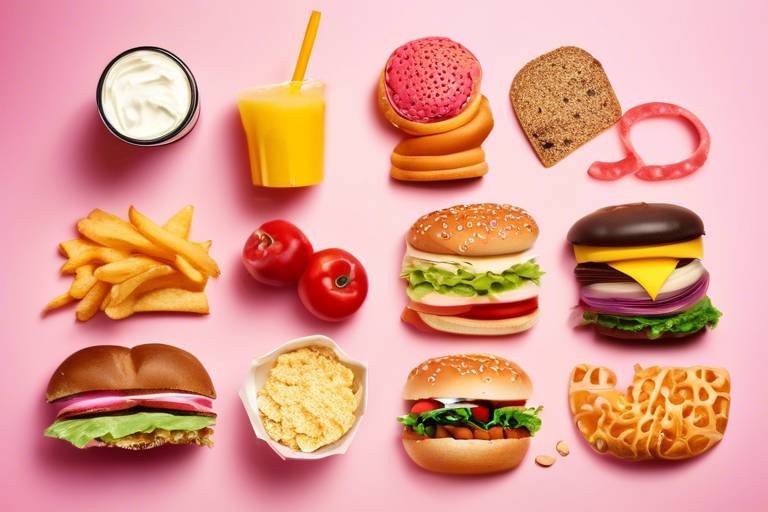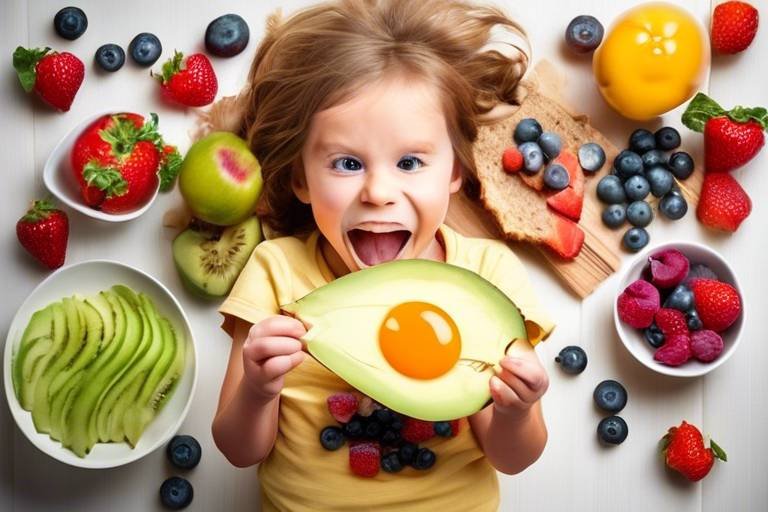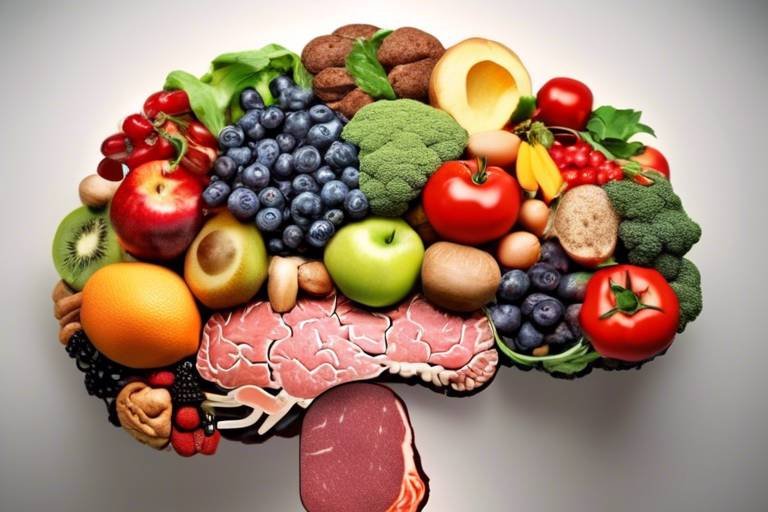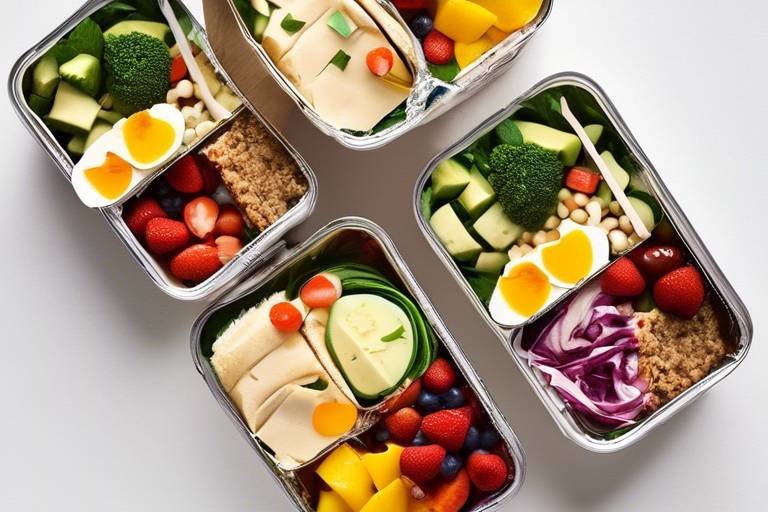Understanding Your Child's Nutritional Needs As They Grow
As parents, we often find ourselves overwhelmed with the myriad of choices when it comes to our children's nutrition. It's like navigating a vast ocean of information where every wave brings a new trend or diet plan. But fear not! Understanding your child's nutritional needs as they grow is essential not just for their physical health but also for their cognitive development. From the moment they enter this world, the food they consume lays the groundwork for their future. Think of it as building a house; you wouldn't start without a solid foundation, right? In this article, we'll dive deep into the nutritional requirements of children at various growth stages, highlighting the importance of a balanced diet that supports every aspect of their development.
During infancy, nutrition is critical for growth and development. It's a time when every bite counts, and the choices made can have lasting effects. Breastfeeding or formula feeding provides essential nutrients to support early brain development and immune function. Did you know that breast milk is often referred to as "liquid gold"? This is because it contains antibodies and nutrients that are perfectly tailored to meet an infant's needs. If breastfeeding isn't an option, formula can provide a balanced alternative. Regardless of the method, ensuring that your baby receives adequate nutrition during this stage is crucial for setting the stage for healthy growth.
As toddlers begin to eat solid foods, it's vital to introduce a variety of nutrients. This stage focuses on developing healthy eating habits and ensuring adequate intake of vitamins and minerals. It's like teaching a child to ride a bike; they need the right balance of support and independence. Parents play a crucial role in guiding their toddlers through this transition. Offering a colorful plate filled with different food groups not only makes meals visually appealing but also ensures a well-rounded diet. Remember, the goal is to create a positive experience around food, encouraging exploration and curiosity.
Understanding the essential nutrients for toddlers, such as iron, calcium, and vitamin D, helps parents make informed dietary choices that promote optimal growth and health. These nutrients are like the building blocks of a sturdy structure, each playing a vital role in your child's development. For example, iron is essential for cognitive development and energy levels. Without it, toddlers can become lethargic and irritable.
Incorporating iron-rich foods like beans, meat, and fortified cereals is crucial for preventing anemia and supporting energy levels in active toddlers. Think of iron as the fuel that keeps their engines running. Here are some tasty options:
- Beans and lentils
- Lean meats
- Fortified cereals
Calcium is vital for developing strong bones and teeth. Incorporating dairy products, leafy greens, and fortified alternatives ensures toddlers meet their calcium needs. Imagine calcium as the scaffolding that supports the entire structure of your child's body. Without it, their growth could be stunted. Some excellent sources of calcium include:
- Milk and yogurt
- Cheese
- Leafy greens like kale and broccoli
Establishing healthy eating habits early can influence a child's long-term relationship with food, making it essential to model balanced eating and involve them in meal preparation. It's not just about what they eat but how they perceive food. By making meal times a family affair, you can instill a sense of responsibility and excitement about nutritious choices. Consider involving them in grocery shopping or cooking; this can transform a mundane task into a fun adventure!
As children enter school, their nutritional needs evolve. A balanced diet supports their increased activity levels and cognitive demands during this critical developmental phase. School-aged children are like sponges, soaking up knowledge and energy, and they need the right fuel to keep them going. Parents should aim to provide meals that are not only nutritious but also appealing to young taste buds.
Healthy snacks can provide additional nutrients and energy throughout the day. Parents should focus on nutrient-dense options to keep kids fueled for learning and play. Think of snacks as mini-meals that can help bridge the gap between breakfast and lunch. Some great options include:
- Fruits and vegetables with hummus
- Whole grain crackers with cheese
- Yogurt with berries
Engaging children in meal planning and preparation fosters a sense of responsibility and encourages them to make healthier food choices, promoting lifelong healthy habits. When children feel involved, they are more likely to try new foods and develop a positive attitude toward eating. It's like giving them a sense of ownership in their health journey.
During adolescence, rapid growth and hormonal changes create unique nutritional needs. Understanding these changes helps ensure that teens receive adequate nutrition for their physical and emotional development. This stage can be challenging, as teenagers often become more independent and may resist parental guidance. However, it's crucial to keep the lines of communication open and provide them with the knowledge they need to make healthy choices.
1. What are the best sources of iron for my toddler?
Iron-rich foods include lean meats, beans, lentils, and fortified cereals. Pairing these with vitamin C-rich foods can enhance iron absorption.
2. How can I encourage my child to eat more vegetables?
Make vegetables fun by involving your child in meal prep, creating colorful plates, and offering a variety of dips for them to try.
3. What snacks are healthy for school-aged children?
Opt for nutrient-dense snacks like fruits, yogurt, whole grain crackers, and nuts to keep their energy levels up throughout the day.

Infants: The Foundation of Nutrition
During the early stages of life, nutrition plays a pivotal role in laying the groundwork for a child's growth and development. Infancy, which spans from birth to about 12 months, is a time when a baby undergoes rapid physical and cognitive changes. This is the period when the body is developing its immune system, brain, and overall health, making the right nutrition absolutely crucial. Parents often wonder what the best feeding practices are, and whether they should opt for breastfeeding or formula feeding. Both methods have their benefits, but the key takeaway is that they provide essential nutrients necessary for a baby’s development.
Breastfeeding is often recommended as it delivers the perfect balance of nutrients tailored to an infant's needs. It not only provides essential vitamins and minerals but also contains antibodies that help protect the baby from infections. On the other hand, infant formula is a great alternative for those who cannot breastfeed. It is designed to closely mimic breast milk and is fortified with iron and other vital nutrients.
During this stage, the focus should be on ensuring that the baby receives adequate amounts of protein, fats, and carbohydrates. These macronutrients play a significant role in brain development and energy levels. For instance, fats are essential for brain development, and they should not be restricted in an infant's diet. Here’s a quick overview of the key nutrients and their importance:
| Nutrient | Importance |
|---|---|
| Protein | Essential for growth and tissue development. |
| Fats | Crucial for brain development and energy. |
| Carbohydrates | Primary energy source for infants. |
| Vitamins & Minerals | Support overall health and development. |
As the infant approaches the six-month mark, parents can start introducing solid foods. This transition is not just about adding variety; it’s about ensuring that the baby receives a range of nutrients necessary for their growth. Foods like pureed fruits, vegetables, and iron-fortified cereals are excellent choices. However, it’s important to consult with a pediatrician to ensure that the introduction of solids is done safely and appropriately.
In summary, the foundation of nutrition during infancy cannot be overstated. The right choices made during this critical period can set the stage for a lifetime of healthy eating habits and overall well-being. By focusing on a balanced intake of nutrients and being attentive to the baby’s needs, parents can ensure their little ones grow up strong and healthy.
- What is the best feeding method for my infant? - Breastfeeding is recommended, but formula feeding is a suitable alternative if necessary.
- When should I start introducing solid foods? - Solid foods can typically be introduced around six months of age.
- What foods should I avoid giving to my infant? - Honey, whole nuts, and foods that may pose a choking hazard should be avoided until the child is older.

Toddlers: Transitioning to Solid Foods
As your little one takes their first steps into the world of solid foods, it's a thrilling time filled with curiosity and exploration. This transition is not just about introducing new textures and flavors; it's about laying the groundwork for a lifetime of healthy eating habits. At this stage, toddlers are like little sponges, soaking up everything around them, including their nutritional needs. Their bodies are growing rapidly, and they require a variety of nutrients to support their development. So, what should you be focusing on during this crucial phase?
First and foremost, variety is key. Just as a colorful palette makes a beautiful painting, a diverse diet creates a healthier child. Aim to introduce a mix of fruits, vegetables, whole grains, proteins, and healthy fats. This not only ensures that your toddler gets the essential nutrients they need but also helps them develop a palate for different tastes. Think of it as a culinary adventure; every meal is an opportunity to explore new flavors and textures!
During this period, it's also vital to establish healthy eating habits. Toddlers are notorious for their picky eating, but this is where your role as a parent becomes crucial. You can encourage them to try new foods by offering small portions and modeling positive eating behaviors. For instance, if they see you enjoying broccoli or quinoa, they might be more inclined to give it a shot themselves. Remember, patience is key. It might take several attempts before they accept a new food, but don't give up!
Another important aspect of this transition is ensuring that toddlers receive adequate amounts of key nutrients. Here are a few you should pay special attention to:
- Iron: Essential for energy and cognitive development. Include foods like beans, meat, and fortified cereals.
- Calcium: Vital for strong bones and teeth. Incorporate dairy products, leafy greens, and fortified alternatives.
- Vitamin D: Helps in calcium absorption. Ensure your toddler gets enough sunlight or fortified foods.
To make this process easier, consider creating a
| Food Type | Examples |
|---|---|
| Iron-Rich Foods | Beans, Lentils, Red Meat, Fortified Cereals |
| Calcium Sources | Dairy Products, Leafy Greens, Fortified Plant Milks |
As you navigate this exciting phase, remember that involving your toddler in meal preparation can also be beneficial. Let them help wash vegetables or stir ingredients. This not only makes them feel included but also sparks their interest in food. When toddlers are part of the cooking process, they're often more willing to try what they've helped create.
Finally, don't forget to keep mealtime fun! Use colorful plates, creative presentations, and even playful names for the dishes. For instance, call broccoli "little trees" or yogurt "dinosaur food." This playful approach can make meals more enjoyable and less of a battleground. After all, the goal is to foster a positive relationship with food that lasts a lifetime.
Q: How can I get my toddler to try new foods?
A: Start by offering small portions of new foods alongside familiar favorites. Be patient and encourage them without pressure. Sometimes, it takes several tries before they accept a new food.
Q: What should I do if my toddler refuses to eat?
A: It's normal for toddlers to have fluctuating appetites. Offer balanced meals and snacks, and try not to stress about it. Keep mealtime positive and relaxed.
Q: Are there foods I should avoid during this transition?
A: Yes, avoid foods that pose choking hazards, such as whole grapes, nuts, or hard candies. Stick to age-appropriate textures and sizes.

Key Nutrients for Toddlers
This article explores the essential nutritional requirements for children at different growth stages, emphasizing the importance of a balanced diet for their physical and cognitive development.
During infancy, nutrition is critical for growth and development. Breastfeeding or formula feeding provides essential nutrients to support early brain development and immune function.
As toddlers begin to eat solid foods, it's vital to introduce a variety of nutrients. This stage focuses on developing healthy eating habits and ensuring adequate intake of vitamins and minerals.
Understanding the essential nutrients for toddlers is crucial for parents aiming to provide a nutritious diet that supports optimal growth and health. At this age, toddlers are like little sponges, absorbing everything around them, including the foods they eat. Their bodies are rapidly growing, which means they require a balanced intake of key nutrients. Among the most important are:
- Iron: Essential for cognitive development and energy levels.
- Calcium: Crucial for strong bones and teeth.
- Vitamin D: Aids in calcium absorption and supports immune function.
- Healthy Fats: Important for brain development.
Each of these nutrients plays a significant role in ensuring that your toddler not only grows physically but also develops cognitively. For instance, iron is a powerhouse nutrient that helps in the formation of hemoglobin, which carries oxygen in the blood. Without adequate iron, toddlers may experience fatigue and developmental delays. Foods rich in iron, such as beans, meat, and fortified cereals, should be staples in their diet.
Incorporating iron-rich foods like beans, meat, and fortified cereals is crucial for preventing anemia and supporting energy levels in active toddlers. Iron can be found in two forms: heme and non-heme. Heme iron, found in animal products, is more easily absorbed by the body compared to non-heme iron, which is found in plant sources. To enhance iron absorption, pairing non-heme iron foods with vitamin C-rich foods like oranges or bell peppers can be beneficial.
Calcium is vital for developing strong bones and teeth. Incorporating dairy products, leafy greens, and fortified alternatives ensures toddlers meet their calcium needs. For instance, a serving of yogurt or cheese can provide a significant portion of their daily calcium requirement. If your child is lactose intolerant or prefers non-dairy options, consider fortified almond or soy milk as excellent alternatives.
Establishing healthy eating habits early can influence a child's long-term relationship with food, making it essential to model balanced eating and involve them in meal preparation. When toddlers see their parents enjoying a variety of foods, they are more likely to mimic those behaviors. It's all about creating a positive food environment where healthy choices are the norm.
As children enter school, their nutritional needs evolve. A balanced diet supports their increased activity levels and cognitive demands during this critical developmental phase.
Healthy snacks can provide additional nutrients and energy throughout the day. Parents should focus on nutrient-dense options to keep kids fueled for learning and play.
Engaging children in meal planning and preparation fosters a sense of responsibility and encourages them to make healthier food choices, promoting lifelong healthy habits.
During adolescence, rapid growth and hormonal changes create unique nutritional needs. Understanding these changes helps ensure that teens receive adequate nutrition for their physical and emotional development.
- What should I do if my toddler refuses to eat certain foods? It's normal for toddlers to be picky eaters. Keep offering a variety of foods without pressure, and try to make mealtime fun.
- How can I ensure my child gets enough iron? Include a mix of heme and non-heme iron sources in their diet, and pair them with vitamin C-rich foods to enhance absorption.
- Are there non-dairy options for calcium? Yes! Fortified plant-based milks, leafy greens, and tofu are great sources of calcium for those who are lactose intolerant.

Iron-Rich Foods
When it comes to ensuring your toddler gets enough iron, it's crucial to understand the role this mineral plays in their overall health. Iron is a key player in the production of hemoglobin, which carries oxygen in the blood. Without sufficient iron, your little one may feel tired and sluggish, impacting their energy levels and ability to explore the world around them. So, how can you ensure your toddler is getting enough of this essential nutrient?
First off, it's important to introduce a variety of iron-rich foods into their diet. You might be wondering what options are available. Well, let’s break it down! Here are some fantastic sources of iron that you can easily incorporate into your toddler's meals:
- Beans and Lentils: These are not only packed with iron but are also high in fiber, making them a great addition to your toddler's diet.
- Meat: Lean meats, especially red meats like beef, are excellent sources of heme iron, which is more easily absorbed by the body compared to non-heme iron found in plant sources.
- Fortified Cereals: Many breakfast cereals are fortified with iron, making them a convenient option for busy mornings.
- Dark Leafy Greens: Spinach and kale not only provide iron but are also rich in vitamins and minerals.
Combining these iron-rich foods with vitamin C can significantly boost iron absorption. For instance, pairing a spinach salad with some orange slices or serving beans with a side of strawberries can help your toddler's body utilize the iron more effectively. It's all about making the right combinations!
Additionally, keep in mind that cooking methods can also affect iron content. For example, cooking in cast iron pans can actually increase the iron content of the food you prepare. So, why not give it a try? Not only will you be enhancing the flavor of your meals, but you'll also be contributing to your child's iron intake.
As you introduce these iron-rich foods, observe how your toddler responds. It’s normal for children to be picky eaters, so patience is key. Make mealtimes fun and engaging by involving them in the cooking process. Let them help wash the vegetables or stir the pot. By making food preparation a family activity, you're not just feeding them; you're also creating lasting memories and fostering a positive relationship with food.
In conclusion, ensuring your toddler receives adequate iron through a balanced diet filled with diverse food options is essential for their growth and energy levels. With a little creativity and involvement, you can help them build a strong foundation for a healthy future.
1. How much iron does my toddler need daily?
The recommended daily allowance for iron varies by age, but toddlers typically need about 7 mg of iron each day. Always consult with your pediatrician to ensure your child meets their nutritional needs.
2. What are the symptoms of iron deficiency?
Symptoms of iron deficiency can include fatigue, weakness, pale skin, and irritability. If you notice any of these signs, consult your healthcare provider for advice.
3. Can too much iron be harmful?
Yes, while iron is essential, too much can lead to toxicity. It's important to balance iron intake and consult with a healthcare professional before starting any supplements.
4. Are there vegetarian sources of iron?
Absolutely! Foods like beans, lentils, tofu, quinoa, and fortified cereals are excellent vegetarian sources of iron. Pairing these with vitamin C-rich foods can enhance absorption.

Calcium Sources
Calcium is an essential mineral that plays a crucial role in developing strong bones and teeth in toddlers. During this stage of growth, children's bodies are rapidly developing, making it vital for parents to ensure they receive adequate calcium. But where can you find this important nutrient? The answer lies in a variety of food sources that can easily be incorporated into your child's diet.
First and foremost, dairy products are among the best sources of calcium. Milk, yogurt, and cheese not only provide calcium but also offer protein and other vital nutrients. For instance, a cup of milk contains about 300 mg of calcium, which is a significant portion of the recommended daily intake for toddlers. If your child enjoys smoothies, blending yogurt with fruits can be a tasty way to sneak in some extra calcium.
For those who are lactose intolerant or prefer non-dairy options, there are plenty of calcium-fortified alternatives available. Many plant-based milks, such as almond, soy, and oat milk, are fortified with calcium, making them excellent substitutes. Just be sure to check the labels to ensure they contain added calcium. Additionally, leafy green vegetables like kale, broccoli, and bok choy are also great sources of calcium. While they may not be as concentrated as dairy, incorporating them into meals can significantly boost calcium intake.
Another fantastic source of calcium is fish, particularly those with edible bones, like sardines and canned salmon. These can be delicious additions to pasta dishes or salads, providing both calcium and omega-3 fatty acids, which are beneficial for overall health. Furthermore, tofu and other soy products can be rich in calcium, especially if they are prepared with calcium sulfate. This means that a stir-fry with tofu can not only be a delightful meal but also a nutritious one.
To summarize, ensuring your toddler gets enough calcium is essential for their growth and development. Here’s a quick overview of some calcium sources:
| Food Source | Calcium Content (mg per serving) |
|---|---|
| Milk (1 cup) | 300 |
| Yogurt (1 cup) | 400 |
| Cheddar Cheese (1 oz) | 200 |
| Fortified Almond Milk (1 cup) | 450 |
| Sardines (3 oz) | 325 |
| Tofu (1/2 cup) | 200 |
| Kale (1 cup, cooked) | 180 |
Incorporating a variety of these foods into your toddler's daily meals can help ensure they receive the calcium necessary for strong bones and teeth. Remember, establishing healthy eating habits early on can set the stage for a lifetime of good nutrition.
- How much calcium does my toddler need? Toddlers aged 1-3 years need about 700 mg of calcium per day.
- What if my child is lactose intolerant? Look for calcium-fortified plant-based milks or include other calcium-rich foods like leafy greens and fish.
- Can calcium be harmful? While calcium is essential, excessive intake can lead to health issues. Always consult a pediatrician for guidance.

Encouraging Healthy Eating Habits
This article explores the essential nutritional requirements for children at different growth stages, emphasizing the importance of a balanced diet for their physical and cognitive development.
During infancy, nutrition is critical for growth and development. Breastfeeding or formula feeding provides essential nutrients to support early brain development and immune function.
As toddlers begin to eat solid foods, it's vital to introduce a variety of nutrients. This stage focuses on developing healthy eating habits and ensuring adequate intake of vitamins and minerals.
Understanding the essential nutrients for toddlers, such as iron, calcium, and vitamin D, helps parents make informed dietary choices that promote optimal growth and health.
Incorporating iron-rich foods like beans, meat, and fortified cereals is crucial for preventing anemia and supporting energy levels in active toddlers.
Calcium is vital for developing strong bones and teeth. Incorporating dairy products, leafy greens, and fortified alternatives ensures toddlers meet their calcium needs.
Establishing healthy eating habits early can have a profound impact on a child's long-term relationship with food. It's not just about what they eat, but how they approach food. One of the most effective strategies is to model balanced eating yourself. Children are like little sponges; they absorb everything around them, including your eating habits. When they see you enjoying a variety of foods, they're more likely to be open to trying new things themselves.
Involving children in meal preparation can also be a game-changer. When kids help out in the kitchen, they feel a sense of ownership over their meals, which can lead to healthier choices. You might start by letting them wash vegetables or measure ingredients. As they grow more comfortable, you can assign them simple tasks like stirring or setting the table. This hands-on experience makes them more aware of what goes into their meals and encourages them to make healthier food selections.
It's also important to create a positive mealtime environment. Make family meals a regular occurrence, where everyone can sit down together without distractions. This not only strengthens family bonds but also provides an opportunity to discuss the importance of nutrition. When children feel relaxed and engaged during meals, they're more likely to enjoy their food and try new dishes.
Lastly, consider introducing a few fun challenges or games around food. For instance, you could have a "color of the week" where each family member tries to incorporate a different colored fruit or vegetable into their meals. This not only makes eating healthier exciting but also teaches kids about the variety and benefits of different foods.
As children enter school, their nutritional needs evolve. A balanced diet supports their increased activity levels and cognitive demands during this critical developmental phase.
Healthy snacks can provide additional nutrients and energy throughout the day. Parents should focus on nutrient-dense options to keep kids fueled for learning and play.
Engaging children in meal planning and preparation fosters a sense of responsibility and encourages them to make healthier food choices, promoting lifelong healthy habits.
During adolescence, rapid growth and hormonal changes create unique nutritional needs. Understanding these changes helps ensure that teens receive adequate nutrition for their physical and emotional development.
- What are some easy ways to encourage my child to eat healthier? Start by modeling healthy eating habits yourself, involve them in meal preparation, and create a positive mealtime environment.
- How can I ensure my toddler is getting enough nutrients? Introduce a variety of foods, including fruits, vegetables, whole grains, and proteins, while focusing on iron and calcium-rich options.
- What snacks are best for school-aged children? Opt for nutrient-dense snacks like yogurt, fruit, nuts, and whole-grain crackers to keep them energized throughout the day.
- Why is family mealtime important? Family meals provide a chance to connect, discuss nutrition, and create a positive relationship with food.

School-Aged Children: Building a Balanced Diet
As children enter the school age, typically between the ages of 6 to 12, their nutritional needs evolve significantly. This is a period where they experience increased activity levels and cognitive demands due to schoolwork and extracurricular activities. It's crucial to establish a balanced diet that not only supports their growth but also fuels their energetic lifestyle. A well-rounded diet during these years can set the stage for healthy eating habits that last a lifetime.
One of the key aspects of a balanced diet for school-aged children is ensuring they receive a variety of nutrients from different food groups. Fruits and vegetables should be a staple on their plates, offering essential vitamins and minerals that support their immune system and overall health. Aim for a colorful plate; the more colors, the more nutrients! Additionally, incorporating whole grains such as brown rice, whole grain bread, and oatmeal can provide the necessary fiber and energy to keep them active throughout the day.
Protein is another critical component of their diet. Children need protein for growth and development, as it helps build and repair tissues. Good sources of protein include lean meats, poultry, fish, eggs, and plant-based options like beans and lentils. However, it’s not just about what they eat, but also how often they eat. Regular meals and healthy snacks can help maintain their energy levels. Consider offering snacks that are both nutritious and appealing, such as:
- Greek yogurt with fruit
- Veggies with hummus
- Whole grain crackers with cheese
Another important aspect of nutrition for school-aged children is hydration. Water should be their primary beverage, as it keeps them hydrated and supports their physical and cognitive functions. While juice and milk can be part of their diet, it's essential to monitor the amounts to avoid excess sugar and calories.
As children grow, they may also become more independent in their food choices, especially with the influence of peers and media. This is where parental guidance plays a vital role. Involving children in meal planning and preparation can help them understand the importance of a balanced diet. When kids participate in cooking, they are often more willing to try new foods and develop a better appreciation for healthy eating.
Moreover, it’s essential to establish a positive eating environment. Family meals can be a great way to encourage healthy eating habits. During these meals, parents can model good eating behaviors, discuss the benefits of various foods, and create a supportive atmosphere that encourages open dialogue about nutrition.
In summary, building a balanced diet for school-aged children is about variety, moderation, and involvement. By providing them with the right foods and engaging them in the process, you can help foster a healthy relationship with food that will benefit them for years to come.
Q: How can I encourage my child to eat more vegetables?
A: Try making vegetables fun! Use colorful dips, create veggie art on their plates, or involve them in the cooking process. The more engaged they are, the more likely they will try new things.
Q: What are some healthy snack options for school?
A: Healthy snacks include fruit slices with nut butter, yogurt parfaits, trail mix with nuts and dried fruits, or whole grain wraps with lean protein.
Q: How important is breakfast for my child?
A: Breakfast is crucial as it kickstarts their metabolism and provides energy for the day ahead. Aim for a balanced breakfast that includes protein, whole grains, and fruit.

Snacks and Their Importance
When it comes to our children’s nutrition, we often think about meals, but let’s not forget the power of snacks. Snacks play a crucial role in maintaining energy levels and providing essential nutrients throughout the day. Imagine your child as a high-performance engine; if you don’t fuel it regularly, it will sputter and stall. The same goes for kids! They need consistent energy to keep up with their busy lives, from school to playdates.
Healthy snacks can serve as a bridge between meals, helping to prevent hunger and ensuring that your child has the energy to learn and play effectively. But what exactly makes a snack healthy? It’s all about the nutrient density. Rather than reaching for sugary treats or processed snacks, opt for options that are rich in vitamins, minerals, and other essential nutrients. Here’s a quick look at some great snack choices:
- Fruits and Vegetables: Fresh fruits and crunchy veggies are packed with vitamins and fiber. Think apple slices with peanut butter or carrot sticks with hummus.
- Nuts and Seeds: These are fantastic sources of healthy fats and protein. Just keep an eye on portion sizes, as they can be calorie-dense.
- Whole Grains: Snacks like whole-grain crackers or popcorn can provide sustained energy and keep your child feeling full.
It’s not just about what snacks to choose; it’s also about when to offer them. Timing can be everything. For instance, offering a nutritious snack before a big homework session can help boost concentration and cognitive function. Think of it as giving them a little fuel before they tackle a big task!
Moreover, involving your children in snack preparation can make them more interested in what they eat. Let them pick out fruits at the grocery store or help prepare a yogurt parfait. This not only teaches them about nutrition but also empowers them to make better food choices. Remember, the goal is to create a positive relationship with food that lasts a lifetime.
In summary, snacks are more than just a way to curb hunger; they are an essential part of a child’s daily nutrition. By choosing healthy options and involving your children in the process, you’re setting them up for success both in and out of the classroom. So next time you’re at the store, think about how you can make snacking a fun and nutritious part of your child’s day!
Q1: How often should my child snack?
A1: It depends on their age and activity level, but generally, offering a healthy snack every 2-3 hours can help maintain their energy levels.
Q2: Are all snacks created equal?
A2: No, snacks can vary greatly in nutritional value. Focus on nutrient-dense options like fruits, vegetables, whole grains, and healthy fats.
Q3: How can I make healthy snacks more appealing?
A3: Get creative! Use fun shapes, involve your kids in preparation, and present snacks in a visually appealing way to make them more enticing.

Involving Children in Meal Planning
Getting your kids involved in meal planning can be a game changer for their relationship with food. Imagine this: instead of simply telling them what’s for dinner, you invite them to be part of the process. This not only empowers them but also makes them more likely to enjoy the meals you prepare together. When children participate in selecting recipes, shopping for ingredients, and even cooking, they develop a sense of ownership over their food choices. It’s like giving them the keys to a delicious kingdom where they can explore and learn!
One of the best parts about involving children in meal planning is that it opens up a dialogue about nutrition. You can discuss the benefits of various foods and why certain ingredients are better than others. For instance, when they choose a recipe that includes leafy greens, you can explain how those greens help build strong bones and keep their energy levels high. This knowledge not only helps them make informed choices but also fosters a lifelong appreciation for healthy eating.
Additionally, involving children in meal planning can be a fun bonding experience. Picture this: you and your child browsing through cookbooks or scrolling through food blogs together, searching for new recipes to try. You can create a list of meals for the week, ensuring a balance of nutrients while also considering their preferences. This collaborative effort can transform the mundane task of meal planning into a delightful adventure!
Here’s a simple table to illustrate how you can structure a weekly meal plan together:
| Day | Meal | Involvement |
|---|---|---|
| Monday | Spaghetti with Marinara Sauce | Child picks the sauce and helps with cooking |
| Tuesday | Taco Night | Child chooses toppings and assembles their own tacos |
| Wednesday | Grilled Chicken Salad | Child selects vegetables and helps with dressing |
| Thursday | Stir-Fry Vegetables and Rice | Child picks vegetables and helps stir-fry |
| Friday | Pizza Night | Child chooses toppings and assembles their pizza |
By creating a plan like this, not only do you ensure healthy meals, but you also allow your child to express their creativity and preferences. Plus, they’re likely to be more excited about eating the meals they helped create! Remember, the goal is to make this experience enjoyable and educational. After all, teaching kids about nutrition and cooking skills at an early age sets the foundation for a healthy lifestyle.
So next time you sit down to plan the week’s meals, grab your child and make it a family affair. Who knows? You might just discover a budding chef in your kitchen!
- Why is it important to involve children in meal planning? Involving children helps them learn about nutrition, builds their confidence in the kitchen, and fosters a positive relationship with food.
- At what age can I start involving my child in meal planning? You can start as early as toddler age! Even young children can help choose simple meals or snacks.
- How can I keep my child engaged in the meal planning process? Make it fun! Use colorful cookbooks, let them pick fun themes like "Taco Tuesday," and encourage them to suggest their favorite meals.

Adolescents: Navigating Nutritional Changes
Ah, adolescence! That whirlwind phase where kids transform into teens, filled with growth spurts, emotional roller coasters, and a seemingly endless appetite. As they navigate this exciting yet challenging period, their nutritional needs shift dramatically. Why is nutrition so crucial during these years? Well, it’s all about supporting their rapid growth and hormonal changes, which can feel like a wild ride. Just like a car needs the right fuel to go fast, teens need a balanced diet to thrive physically and mentally.
During adolescence, the body undergoes significant changes. Boys may experience a growth spurt that can add several inches in just a few months, while girls often see shifts in body composition and development. This is when the body demands a variety of nutrients to support these changes. Key nutrients include:
- Protein: Essential for muscle growth and repair.
- Calcium: Crucial for developing strong bones, especially since 90% of bone mass is built by age 18.
- Iron: Needed to support increased blood volume and muscle development.
- Vitamins: Essential for energy production and overall health.
But how do parents ensure their teens are getting all these nutrients? It’s essential to create a balanced diet that includes a variety of foods. Think of it as building a colorful plate: the more colors, the more nutrients! Incorporating foods from all the food groups can help meet these nutritional needs. For example, a typical day could look like this:
| Meal | Food Options |
|---|---|
| Breakfast | Oatmeal topped with berries and a glass of milk |
| Lunch | Turkey sandwich on whole grain bread with a side of carrot sticks |
| Snack | Greek yogurt with honey and nuts |
| Dinner | Grilled chicken, quinoa, and steamed broccoli |
It’s also important to remember that teens are often influenced by their peers and the media. This can sometimes lead to unhealthy eating habits, such as skipping meals or following fad diets. Parents can combat this by encouraging open conversations about nutrition and body image. Engaging teens in meal planning and preparation can also empower them to make healthier choices. After all, when they have a hand in creating their meals, they’re more likely to eat what’s on their plates!
Finally, hydration should not be overlooked. With increased activity levels, teens need to drink plenty of water. It’s easy to forget about hydration when busy with school and sports, but staying hydrated is just as important as eating well. A good rule of thumb is to encourage teens to drink water throughout the day, especially before and after physical activities.
In conclusion, navigating the nutritional needs of adolescents can feel overwhelming, but it doesn’t have to be. By focusing on a balanced diet rich in essential nutrients, parents can support their teens through this transformative stage. Remember, it’s all about creating healthy habits that will last a lifetime!
1. What are the most important nutrients for adolescents?
During adolescence, key nutrients include protein, calcium, iron, vitamins, and healthy fats. These nutrients support growth, development, and overall health.
2. How can I encourage my teen to eat healthier?
Involve them in meal planning and preparation, provide a variety of healthy food options, and maintain open discussions about nutrition and body image.
3. Is it okay for my teen to diet?
It’s essential to approach dieting with caution. Instead of restrictive diets, focus on balanced eating and healthy habits. If weight management is a concern, consult a healthcare professional.
Frequently Asked Questions
- What are the essential nutrients for infants?
Infants require a range of essential nutrients, primarily obtained through breastfeeding or formula feeding. These include proteins, fats, carbohydrates, vitamins, and minerals, which are crucial for their rapid growth, brain development, and immune function.
- How can I ensure my toddler is getting enough iron?
To ensure your toddler gets enough iron, incorporate iron-rich foods into their diet. Options include beans, lean meats, fortified cereals, and dark leafy greens. Pairing these with vitamin C-rich foods can enhance iron absorption.
- What are some healthy snacks for school-aged children?
Healthy snacks for school-aged children can include fruits, vegetables with hummus, yogurt, whole-grain crackers, and nuts. These options provide essential nutrients and energy, helping to keep kids focused and active throughout the day.
- How can I involve my child in meal planning?
Involving your child in meal planning can be a fun and educational experience. Encourage them to choose recipes, help with grocery shopping, and participate in meal preparation. This not only fosters a sense of responsibility but also helps them develop healthy eating habits.
- What nutritional changes occur during adolescence?
During adolescence, children experience rapid growth and hormonal changes, leading to increased nutritional needs. Key nutrients include protein for muscle development, calcium for bone growth, and iron to support increased blood volume. It's essential to ensure teens have a balanced diet to meet these needs.
- How can I encourage my child to eat a balanced diet?
To encourage a balanced diet, model healthy eating habits yourself, offer a variety of foods, and make mealtime enjoyable. Involve your child in cooking and educate them about the benefits of different foods. Positive reinforcement and patience are key!







